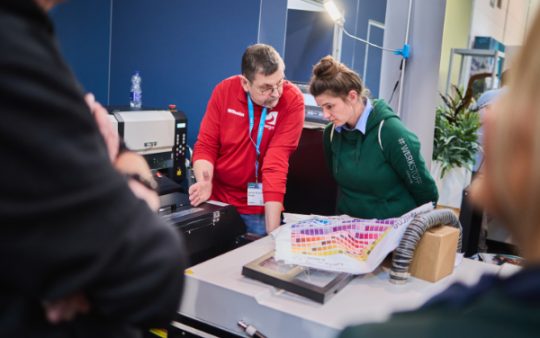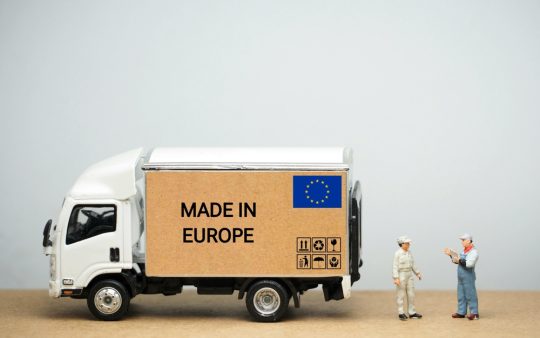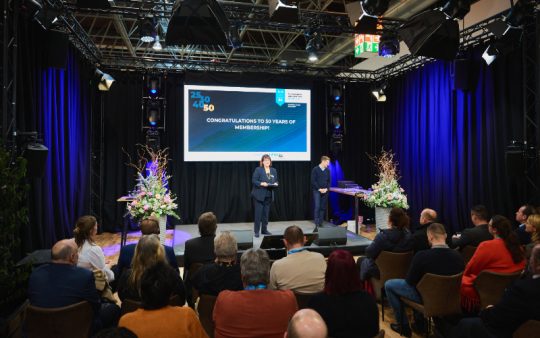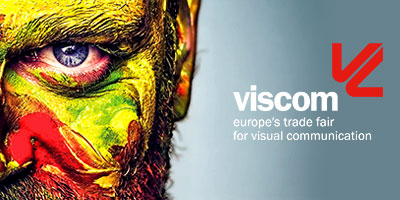“Make Your Shirt” – digitalisation as a journey of adventure

Published on 18.11.2019
Digitalization is one of those challenges that also offers new chances for the future in the world of sales and advertising. Visitors to PSI, viscom and PromoTex, held at Düsseldorf Exhibition Centre from 7th – 9th January 2020, can learn all about the opportunities offered by a networked production chain. In the special “Make Your Shirt” area in Hall 13, Smake will be inviting you to go on a journey, from placing an order right through to taking delivery of your garment, all with the aid of a simple QR code. The company does not just embroider and print personalised clothing as a single item on demand, it has also developed software solutions that make finishing processes both scalable and cost-effective. A peek behind the company’s doors at its plant in Castrop-Rauxel gives a clue to its underlying concept and the benefits it has to offer.
To boldly go…
It is the continuous chatter of the embroidery machines that sets the tone in Smake’s production halls in Castrop-Rauxel. Lined up in two rows, the machines largely work autonomously. Only every now and then does somebody walk by, scrutinising the different garments being processed. On the floor below, you can hear the steady rhythmic rustle of plastic bags as well-practised hands, armed with a small gun, attach bar-coded labels to red, white and blue shirts, black fleece jackets and blue trousers, before laying them in the appropriate boxes.
“Things tend to be a bit chaotic here, but thanks to the barcode all the right products come together again at the end of the process”, says CEO Mark Busche, who co-founded the company with Thomas Drees. “We started out importing surfing equipment, and after that we started producing our own products. That’s how we finished up in textiles and textile finishing”, the dynamic-looking business partners add. Nowadays, they both surf successfully together on the digitalization wave. Thomas Drees recalls their first steps in developing their own software, “When we discovered that the market had moved on, we decided we wanted to try something new”. Since then, eleven IT experts have not just been beavering away in the in-house IT department optimizing the company’s internal production, they have also been preparing it for use by other companies in the industry.
Straight from the customer into production
Thomas Drees demonstrates just what that means with a small finger-exercise on his keyboard. The user interface of an online shop appears on the large monitor in front of him. “The customer selects his garment and then configures a motif”, the Smake manager explains. With just a few clicks, he selects a white polo shirt, which he goes on to decorate with his own name in red letters. “You can also choose from different print motifs”, he says, scrolling through a wealth of suggestions that include some sassy slogans, Miami Beach sunsets and stag-night beers. “The customer’s choice of garment and the positioning of his motif are recorded in the order, which goes straight into production, and this information can always be verified thanks to the accompanying barcode.”

There is a brief beep as Oliver, who works in the incoming goods section, scans the barcode on a black shirt. His tablet screen informs him that the shirt should be printed on both sides. Oliver throws it into a tube recessed into the table. The garment travels directly to the floor below, landing softly on a heap of other clothes in a box. There, Robert reaches for the shirt, scans the code, lays the small black shirt in the printing machine and presses a button. The carrier grid starts moving and the shirt disappears into the printer. Thomas Drees adds, “The data that goes to the machine has been precisely matched with the garment. Each printing machine has its own particular colour characteristics, which we compensate for with calibration, thus guaranteeing consistent high colour quality and customer satisfaction”.

Global Network
Storing data in the cloud and the consistent end-to-end configuration of the system permits companies to be linked worldwide in the field of textile finishing. “Our software is free and can be used to control different makes of machine”, says Thomas Drees, who already sells his product made of bits and bytes in 21 countries. His vision is decentralised manufacture by interconnected companies. “A customer in New York, for example, could order a sweatshirt for a friend in Australia. The order would then go directly to a local company so that the product could be delivered that very same day. This is the only way that smaller companies will be able to stay competitive in comparison to the Internet giants”, Thomas Drees emphasises, running his hand through his long, dark-blond curls.
While staff member Robert puts the freshly printed shirt in the dryer, reminiscent of an enormous hairdryer, Mark Busche pulls out a red hoody from a pile of similar garments. “The red dot on the barcode indicates that the product has already been here too long and needs prioritising”, explains the CEO. “As a rule, there will be no more garments left here by this evening because we print 1400 shirts on demand in a single shift and then as many again in the embroidery department.”
Controlled quality
The 35 machines at the back of the hall are still chattering away unceasingly at 700 stitches per minute. “We could go faster, but we want to keep the number of complaints to an absolute minimum. Which is why we also use high quality embroidery backing and good thread”, says Mark Busche, watching the needles pounding up and down. At a table, Christina scans the code of a grey jacket. A motif and its desired position appear on the display, and with a few skilful hand movements, she clamps the garment in the embroidery frame. At the same time, her colleague at the next table tidies up a finished pair of embroidered trousers, folds them up and puts them into a box for dispatch.
Things are relatively quiet in the packing area. Scanning barcodes, folding and bagging garments, sticking on addresses and boxing up products are all clearly routine tasks for the staff. “This is also where we do the quality control”, says Mark Busche. “If the printing were to be missing from the back of the black shirt, for example, the software would inform the staff member not to dispatch the item. If, on the other hand, it has been finished both sides and been bagged, the system tells the member of staff in just which dispatch box the shirt belongs – and then off it goes to the post office.”

About viscom
Europe’s trade fair for visual communication is the annual trade fair for people who use the services of international advertisers. Taking place at the beginning of January, it is really the overture to the new business year. viscom presents solutions from across the whole world of visual communication, with a special focus on digital large format printing, advertising technology, textile finishing machines and POS communication. The next viscom takes place from 7th – 9th January, 2020 in Dusseldorf, parallel to PSI – Europe’s leading promotional product trade fair – and PromoTex Expo, the international trade fair for promotional, sports and workwear. Together, they form the biggest trade fair affiliation in Europe devoted to sales and advertising, and which anticipates more than 1000 exhibitors and around 30,000 trade visitors from all over the world.














